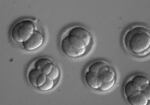
In this microscope photo provided by Oregon Health & Science University, human embryos grow in a laboratory for a few days after researchers used gene editing technology to successfully repair a heart disease-causing genetic mutation.
Oregon Health & Science University
A team of researchers at Oregon Health & Science University has officially become the first in the United States to use a gene-editing tool to target a disease-causing mutation.
They say it's a scientific breakthrough that could prevent inherited diseases from spreading to future generations.
The research, published Wednesday in the journal Nature, shows researchers successfully used the gene-editing tool known as CRISPR to correct a mutation in nuclear DNA that causes a genetic heart disease.
Related: Report: OHSU Scientist 1st In US To Modify Human Genes With CRISPR
The MYBPC3 mutation can cause heart disease and heart failure and is a common cause of sudden cardiac arrest in young people.
“The potential is enormous,” said Sanjiv Kaul, professor of cardiovascular medicine at the OHSU School of Medicine. “People are using CRISPR mostly to create mutations in animals to cause disease, so we said ‘why don’t we use it to remove the disease?’”
Critics of CRISPR have expressed concern over how the technology could be used to make "designer babies."
At a press conference Wednesday, Shoukhrat Mitalipov, the OHSU researcher who led the study, said he’s opposed to that direction and is worried about that unintended use. But he also says the research is crucial.
“This has always been a controversial area,” said Mitalipov. “But we believe we have to look into embryos and do research on embryos in order to understand the biology and genetics of the embryos if we’re ever going to treat these diseases.”
The research is still in its beginning stages, but the breakthrough gives researchers insight into how safe and efficient embryo repairs could be using the CRISPR technology, which could theoretically allow scientists to eventually cure diseases including cancer.